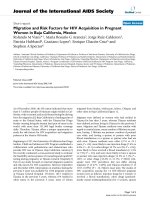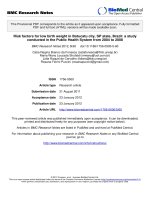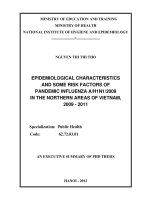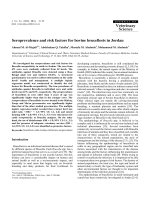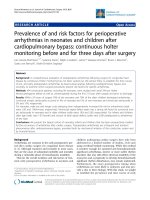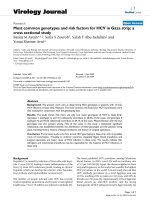Incidence and risk factors for intussusception among children in northern Israel from 1992 to 2009: A retrospective study
Bạn đang xem bản rút gọn của tài liệu. Xem và tải ngay bản đầy đủ của tài liệu tại đây (432.7 KB, 9 trang )
Muhsen et al. BMC Pediatrics 2014, 14:218
/>
RESEARCH ARTICLE
Open Access
Incidence and risk factors for intussusception
among children in northern Israel from 1992 to
2009: a retrospective study
Khitam Muhsen1*†, Eias Kassem2†, Sigalit Efraim1, Sophy Goren1, Dani Cohen1 and Moshe Ephros3
Abstract
Background: Determining the background incidence of intussusception is important in countries implementing
rotavirus immunization. Rotavirus immunization was introduced into the routine infant immunization program in
Israel during late 2010. Incidence and risk factors for intussusception were examined in children aged less than five
years between 1992 and 2009.
Methods: Data were collected from medical records of children hospitalized due to intussusception (N = 190), and
from control children (N = 295), at Carmel and Hillel Yaffe hospitals in northern Israel.
Results: The average annual incidence of intussusception in Jewish and Arab children aged less than five years
was estimated at 36.1 (95% CI 17.0-76.5) vs. 23.2 per 100,000 (95% CI 9.3-57.9); for infants less than 12 months of
age- 128.1 (95% CI 53.0-309.6) vs. 80.1 (95% CI 29.1-242.6) per 100,000. The risk of intussusception was higher in
infants aged 3–5 months: OR 5.30 (95% CI 2.11-13.31) and 6–11 months: OR 2.53 (95% CI 1.13-5.62) when compared
to infants aged less than 3 months; in those living in low vs high socioeconomic communities: OR 2.81 (95% CI
1.45-5.43), and in children with recent gastroenteritis: OR 19.90 (95% CI 2.35-168.32) vs children without recent
gastroenteritis. Surgical reduction was required in 23.2%. The likelihood of surgery was significantly increased in
patients presenting with bloody stool, in Arabs and those who were admitted to Hillel Yaffe Hospital.
Conclusions: The incidence of intussusception prior to universal rotavirus immunization was documented in
northern Israel. Despite the lower incidence, Arab patients underwent surgery more often, suggesting delayed
hospital admission of Arab as opposed to Jewish patients.
Keywords: Intussusception, Risk factors, Surgery, Ethnicity, Pediatrics
Background
Intussusception is among the most common abdominal
emergencies among young children [1-4]. Symptoms include sudden onset of vomiting, abdominal pain, intermittent lethargy and irritability, and rectal bleeding that has
been described as “currant jelly” [3-6]. Reduction is usually
accomplished by air or barium enema, and in some cases
by surgery, with or without bowel resection [3,4,6]. Intussusception primarily affects young children [3,5], with highest incidence in infants aged 4–10 months [3-5]. Reported
* Correspondence:
†
Equal contributors
1
Department of Epidemiology and Preventive Medicine, School of Public
Health, Sackler Faculty of Medicine, Tel Aviv University, Ramat Aviv, Tel Aviv
69978, Israel
Full list of author information is available at the end of the article
yearly estimates of intussusception vary among populations
and regions from 20 to 100 per 100,000 infants [3,7-9], but
a higher incidence has also been reported [10].
The causes of intussusception are not fully understood,
yet, there is evidence linking recent episodes of gastroenteritis and increased risk of intussusception [11,12].
Adenovirus was repeatedly recovered in higher proportions from fecal samples of patients with intussusception
compared with control children [13-15], however no association has been found between natural rotavirus infection
and intussusception [15-17].
In 1998 the reassortant rhesus human tetravalent oral
rotavirus vaccine (RotaShield, Wyeth-Lederle, Pearl River,
NY) was licensed in the United States. Shortly after
its introduction into the routine childhood vaccination
© 2014 Muhsen et al.; licensee BioMed Central Ltd. This is an Open Access article distributed under the terms of the Creative
Commons Attribution License ( which permits unrestricted use, distribution, and
reproduction in any medium, provided the original work is properly credited. The Creative Commons Public Domain
Dedication waiver ( applies to the data made available in this article,
unless otherwise stated.
Muhsen et al. BMC Pediatrics 2014, 14:218
/>
schedule, an excess risk for intussusception was found
within 2 weeks after immunization with the first dose [1
intussusception case per 10,000 vaccinees [18-20]]. Consequently the vaccine was withdrawn from the market in
1999. Large clinical trials with two recent oral rotavirus
vaccines (RotaTeq (Merck) [21] and Rotarix (GSK) [22]),
and early post-marketing studies [23,24] showed no significant increase in post-immunization intussusception.
However, later studies showed that in some settings e.g.,
Australia, and Mexico, there is an increased risk of intussusception during the first week post vaccination with the
first dose of either rotavirus vaccine [25-27]. At present,
this rare adverse event is estimated at about 1–2 intussusception cases per 100,000 vaccine recipients [28,29], nonetheless the vaccine’s benefits clearly exceed this small risk,
thus rotavirus vaccines are recommended for use worldwide [29]. It is important to establish the baseline incidence of intussusception to assess the safety of rotavirus
vaccines [3,29,30] in countries considering the introduction of rotavirus vaccination.
In Israel, rotavirus was found to be the most common
pathogen causing acute gastroenteritis, and was detected
in 39% of children less than 5 years of age hospitalized for
diarrhea [31], leading to more than 4000 hospitalizations
countrywide annually [31]. Both Rotarix and RotaTeq
were licensed in Israel in mid-2007, but it was only in
December 2010 that RotaTeq was included in the national immunization program. The aims of this study were
to examine the incidence, clinical characteristics and potential correlates of intussusception among children less
than five years of age from January 1st, 1992 to December
31st, 2009, before the introduction of rotavirus vaccine
into the national immunization program.
Methods
The study was conducted in two hospitals in northern
Israel: Carmel in Haifa and Hillel Yaffe in Hadera. The
population residing in the catchment area of the two
hospitals includes representation of the two major ethnic
groups of the Israeli population, Jews and Arabs. It is estimated that 20% and 90% of children aged 0–4 years in
Haifa and Hadera sub-districts, respectively, receive inpatient services at these facilities. Based on this information and on publications of the Israel Central Bureau of
Statistics the estimated number of children less than five
years of age residing in the study area ranged from 29,000
in 1992 to 40,700 in 2009 (annual average 35,600).
We identified children less than five years of age who
were hospitalized with intussusception (n = 190) at the
study hospitals between January 1st, 1992 and December
31st, 2009 by searching for the ICD-9 diagnosis code for
intussusception (560.0) in discharge records. All records with
this code were retrieved regardless of its being a primary or
secondary diagnosis. Also the word “intussusception” was
Page 2 of 9
searched in text regardless of diagnosis coding. In both
hospitals, the diagnosis of intussusception was based on
radiological findings, usually ultrasound. In order to
examine the correlates of intussusception, we retrieved records of control children (N = 295) hospitalized for reasons other than intussusception. The primary diagnoses of
the control children were trauma (50.3%), otitis media
(23.8%), local infection (17%) (e.g., cellulitis, abscess, mastoiditis, urinary tract infection), fever (4.1%), and elective
procedures/other (4.8%). From the archives of each hospital, we retrieved lists of potential consecutive control
children with these diagnoses. Intussusception cases and
control children were frequently matched by hospital,
sex, season/date of admission (±2 months). We did not
strictly match cases and controls by age; however
��������������������������������������������������������������������������������������������������������������������������������������������������������������������������������������������������������������������������������������������������������������������������������������������������������������������������������������������������������������������������������������������������������������������������������������������������������������������������������������������������������������������������������������������������������������������������������������������������������������������������������������������������������������������������������������������������������������������������������������������������������������������������������������������������������������������������������������������������������������������������������������������������������������������������������������������������������������������������������������������������������������������������������������������������������������������������������������������������������������������������������������������������������������������������������������������������������������������������������������������������������������������������������������������������������������������������������������������������������������������������������������������������������������������������������������������������������������������������������������������������������������������������������������������������������������������������������������������������������������������������������������������������������������������������������������������������������������������������������������������������������������������������������������������������������������������������������������������������������������������������������������������������������������������������������������������������������������������������������������������������������������������������������������������������������������������������������������������������������������������������������������������������������������������������������������������������������������������������������������������������������������������������������������������������������������������������������������������������������������������������������������������������������������������������������������������������������������������������������������������������������������������������������������������������������������������������������������������������������������������������������������������������������������������������������������������������������������������������������������������������������������������������������������������������������������������������������������������������������������������������������������������������������������������������������������������������������������������������������������������������������������������������������������������������������������������������������������������������������������������������������������������������������������������������������������������������������������������������������������������������������������������������������������������������������������������������������������������������������������������������������������������������������������������������������������������������������������������������������������������������������������������������������������������������������������������������������������������������������������������������������������������������������������������������������������������������������������������������������������������������������������������������������������������������������������������������������������������������������������������������������������������������������������������������������������������������������������������������������������������������������������������������������������������������������������������������������������������������������������������������������������������������������������������������������������������������������������������������������������������������������������������������������������������������������������������������������������������������������������������������������������������������������������������������������������������������������������������������������������������������������������������������������������������������������������������������������������������������������������������������������������������������������������������������������������������������������������������������������������������������������������������������������������������������������������������������������������������������������������������������������������������������������������������������������������������������������������������������������������������������������������������������������������������������������������������������������������������������������������������������������������������������������������������������������������������������������������������������������������������������������������������������������������������������������������������������������������������������������������������������������������������������������������������������������������������������������������������������������������������������������������������������������������������������������������������������������������������������������������������������������������������������������������������������������������������������������������������������������������������������������������������������������������������������������������������������������������������������������������������������������������������������������������������������������������������������������������������������������������������������������������������������������������������������������������������������������������������������������������������������������������������������������������������������������������������������������������������������������������������������������������������������������������������������������������������������������������������������������������������������������������������������������������������������������������������������������������������������������������������������������������������������������������������������������������������������������������������������������������������������������������������������������������������������������������������������������������������������������������������������������������������������������������������������������������������������������������������������������������������������������������������������������������������������������������������������������������������������������������������������������������������������������������������������������������������������������������������������������������������������������������������������������������������������������������������������������������������������������������������������������������������������������������������������������������������������������������������������������������������������������������������������������������������������������������������������������������������������������������������������������������������������������������������������������������������������������������������������������������������������������������������������������������������������������������������������������������������������������������������������������������������������������������������������������������������������������������������������������������������������������������������������������������������������������������������������������������������������������������������������������������������������������������������������������������������������������������������������������������������������������������������������������������������������������������������������������������������������������������������������������������������������������������������������������������������������������������������������������������������������������������������������������������������������������������������������������������������������������������������������������������������������������7 (5.8)
33.3 (5.6)
1.04 (0.99-1.09)
0.078
Maternal age (yrs), mean (SD)a
31.0 (5.1)
29.6 (5.1)
1.05 (1.00-1.11)
0.045
SES of residence town, n (%)a
Low
66 (42.9)
73 (29.4)
2.29 (1.32-3.97)
0.003
Intermediate
60 (39.0)
104 (41.9)
1.46 (0.85-2.51)
0.16
High
28 (18.2)
71 (28.6)
Reference
Birth weight, n (%)
Birth weight < 2500 gra
6 (4.2)
14 (6.0)
Reference
Birth weight ≥ 2500 gr
138 (95.8)
221 (94.0)
1.45 (0.54-3.88)
6 (4.3)
10 (4.6)
Reference
135 (95.7)
206 (95.4)
1.09 (0.38-3.07)
0.44
Birth week, n (%)
Less than 37 weeks
≥ 37 weeks
0.86
Gastroenteritis before admission, n (%)
Yes
12 (6.3)
1 (0.3)
19.82 (2.55-153.72)
No
178 (93.7)
294 (99.7)
Reference
Breastfed aged < 1 yr
50 (37.3)
40 (28.2)
Reference
Not breasted children aged <1 yr
84 (62.7)
102 (71.8)
0.65 (0.39-1.09)
<0.001
Breastfeeding < 1 yr, n (%)
0.10
Breastfeeding 1–4 yrs, n (%)
Breastfed children age 1-4 yrs
9 (16.1)
8 (5.2)
Reference
Not breasted children age 1-4 yrs
47 (83.9)
145 (94.8)
0.28 (0.10-0.78)
0.011
a
Data on maternal and paternal age were available for 93 (47%) cases and 143 (48%) controls. Information on birth week was available for 141 (74%) cases and
216 (73%) controls, and on birth weight it was available for 144 (76%) cases and 235 (80%) controls. Information on SES of place of residence was available for
154 (81%) cases and 248 (84%) controls.
in Europe [33-35], and about 2–3 fold higher than rates
reported in the United States [7,36]. The incidence of
intussusception in infants in this region of northern
Israel decreased over time, in concert with previous
studies [7,34,36,37].
The incidence of intussusception was higher among
Jewish than Arab children, in agreement with an earlier
study in southern Israel [10], where the incidence among
Jewish and Bedouin children less than five year of age
was estimated at 49.3 and 18.9 per 100,000, respectively,
and for infants 199.6 and 66.8 per 100,000, respectively
[10]. Ethnic differences in the incidence of intussusception have been described before [7,9,36-38]. Higher risk
of intussusception has been noted among black and
Hispanic children vs white, non-Hispanic children in the
United States [7,36,38]. In Australia and New Zealand
lower incidence of intussusception was observed in indigenous infants compared to non-indigenous infants [37],
and specifically, among Maori compared with European
infants, respectively [9].
About two thirds of intussusception cases occurred in
infants 3–11 months of age; the risk of intussusception
increased substantially by 5 fold in children aged 3–5
months compared to younger infants while children
aged 6–11 months had about 2-fold increased risk of
intussusception compared to the youngest age group
(<3 months). Increased risk of intussusception was found
more among children who lived in low socioeconomic
communities than among those who lived high socioeconomic settings. A previous study from the United States
showed that infants enrolled in Medicaid, used as a marker
for low socioeconomic status, had 1.5 fold increased risk of
Muhsen et al. BMC Pediatrics 2014, 14:218
/>
Page 6 of 9
Table 3 Multivariable logistic regression model of the risk
factors for intussusception in children less than 5 years
of age
Adjusted OR (95% CI)*
Pv
Age (months)
Table 4 Correlates of surgery among cases with
intussusception
Total
Surgery, n (%)
Pv
< 1 year
134
36 (26.9)
0.11
1-4 years
56
9 (16.1)
Age
<3
Reference
3-5
5.30 (2.11-13.31)
<0.001
6-11
2.53 (1.13-5.62)
0.023
Males
119
33 (27.7)
12-23
0.73 (0.32-1.65)
0.4
Females
71
12 (16.9)
24-59
2.01 (0.73-5.99)
0.1
Ethnic group
Arabs
76
25 (32.9)
Jews
114
20 (17.5)
Low
66
21 (31.8)
Intermediate
60
11 (18.3)
High
28
2 (7.1)
Socioeconomic rank
of place of residence
Low
Intermediate
High
2.81 (1.45-5.43)
0.002
1.66 (0.87-3.16)
0.1
Reference
0.12
Gastroenteritis prior
to hospitalization
No
Reference
Yes
19.90 (2.35-168.32)
Sex
0.089
0.015
Socioeconomic rank of residence place
0.006
Hospital
0.006
*Variables entered to the model at step 1: age, socioeconomic rank of place of
residence, history of gastroenteritis, hospital, and breastfeeding. Data presented
in the table are the final model which included the variables in the table
and hospital.
intussusception [39]. It is not clear what underlying mechanisms might explain the association of intussusception
and socioeconomic strata, but it is possible that genetic,
environmental and cultural exposures including exposure
to enteric pathogens and child nutritional practices [3]
may play a role. In this study, recent history of gastroenteritis was associated with increased the risk of intussusception, and similar findings have been shown in other
studies [11,12]. However, it is possible that our findings
overestimate such an association, since physicians may
have questioned parents of control children less intensively than intussusception patients’ parents on a recent
history of gastroenteritis.
The common clinical symptoms of intussusception were
similar to those reported previously; it is worth mentioning that visible (macroscopic) blood in stool was documented in only 39% of cases, and it appeared more than
twofold in infants compared with toddlers. Irritability was
also common, reported in 69%. This is probably due to
the fact that infants and young children lack the ability to
express pain verbally. These findings suggest that suspecting intussusception in children presenting with “atypical”
symptoms is warranted.
The median hospital stay was 2 days, but reached 12 days
in some cases. Usually, reduction with conservative treatment like air or barium enema was successful, but surgery
was required in about 1/4 of intussusception patients. The
percentage of intussusception patients undergoing surgery varied widely in previous studies - from 12% to
Hillel Yaffe Medical Center
100
33 (33.0)
Carmel Medical Center
90
12 (13.3)
Breastfed
59
17 (28.8)
Not breasted
131
28 (21.4)
No
117
22 (18.8)
Yes
73
23 (31.5)
No
44
6 (13.6)
Yes
146
39 (26.7)
No
154
41 (26.6)
Yes
36
4 (11.1)
No
59
17 (28.8)
Yes
131
28 (21.4)
0.001
Breastfeeding
0.26
Blood in the stool
0.045
Vomiting
0.074
Diarrhea
0.052
Irritability
0.26
Table 5 Multivariable analysis of factors associated with
surgery among patients with intussusception
Unadjusted
OR (95% CI)
Adjusted
OR (95% CI)*
Pv
Hillel Yaffe Medical Center
vs. Carmel Medical Center
3.20 (1.53-6.69) 4.42 (1.70-11.46) 0.002
Arabs vs. Jews
2.30 (1.16-4.54)
2.32 (0.99-5.45)
0.05
Blood in the stool (yes vs. no) 1.98 (1.00-3.91)
2.78 (1.17-6.60)
0.021
Diarrhea (yes vs. no)
0.22 (0.05-1.1)
0.06
0.34 (0.11-1.03)
*In addition to the variables in the table, the variables socioeconomic status of
place of residence, age, sex, and interaction between ethnicity and hospital
were added to the analysis. The adjusted ORs and Pv presented in the table
were obtained from the final model.
Muhsen et al. BMC Pediatrics 2014, 14:218
/>
88% [3]. In our study, children who presented with bloody
stool, Arabs, and those who were admitted to Hillel Yaffe
Medical Center were more likely to undergo surgery. Despite the lower incidence of intussusception among Arab
children, they underwent surgery about twice as often as
did Jewish children. Interestingly a previous study from
southern Israel also showed that Bedouin children with intussusception were more likely to undergo surgery than
their Jewish peers [10]. However, in the southern Israel,
about 50% of the Bedouin population lives in remote villages so that limited access to primary health care might
explain why Bedouin children require surgery more often.
This is not the case in northern Israel. In the study area,
despite the fact that Arab residents live mostly in separate
towns and villages, all have a basic infrastructure similar to
that of Jewish communities, including on-site primary care
clinics run by the main health maintenance organizations.
Furthermore, in 1995 the National Health Insurance law
was implemented in Israel, resulting in near uniform access to health care, preventive, ambulatory and inpatient
services, thus minimizing disparities between Arab and
Jewish populations. In the United States bowel resection
was significantly increased in patients who had the symptoms for 2 days or more before admission compared
to those who were admitted earlier [38]. Therefore, taking into account the characteristics of the study communities we postulate that admission may be delayed in some
Arab patients with intussusception. This may be due to
different referral behaviors of community physicians in
Arab towns, parental perception of intussusception symptoms as non-serious (e.g., mistakenly confused with
gastroenteritis), or both. If this hypothesis is proven true,
the potential exists to reduce the need for intussusception surgery, especially in Arab children, by educating
parents on when to seek medical care for young children
with possible intussusception, and when pediatric caregivers in community practice should refer children to hospital for suspected intussusception. This finding may be
relevant to countries with multiple ethnicities as well.
Since mostly Arab physicians work in clinics in the Arab
towns and villages, there is a possibility of a combined
doctor-patient ethnic effect upon the decision whether
or not to refer patients to hospital for further evaluation. Since the incidence of intussusception in Arab
children is lower than that found among Jewish children,
seeking medical attention might be delayed for intussusception with mild symptoms which might, in some cases,
resolve spontaneously. This could lead to higher risk estimates for surgery among Arab vs. Jewish children. Therefore, the average incidence of intussusception associated
with surgery was calculated, and was found to be higher
among Arab vs. Jewish children (7.50 vs. 6.83 per 100,000
children less five years of age, but this difference was not
significant).
Page 7 of 9
The review of hospital records over an 18 year period
from 2 hospitals in northern Israel yielded robust estimates of the incidence of intussusception, its clinical
symptoms and treatment strategies prior the introduction of universal rotavirus immunization in Israel. The
diagnosis of intussusception relied on radiological and/
or sonographic findings throughout the study period in
both medical centers. A case–control design was utilized
to obtain insight in to the correlates of intussusception.
These can be regarded as strengths of the study. Yet the
study has some notable weaknesses: variability in obtaining clinical history probably occurred over time and
among pediatricians. Hospital controls may not be the
optimal control group, yet these groups were from the
same source population and were comparable in terms
of sex, study period, geographic region and ethnicity.
Conclusions
We documented a relatively low incidence of pediatric
intussusception prior the introduction of universal rotavirus immunization in Israel, but higher than that found
in European and US children. Although incidence was
lower among Arabs than Jews, the former group was more
likely to undergo surgery, suggesting the possibility of delayed admission of Arab patients to hospital resulting
from specific referral patterns of physicians and/or health
care seeking behaviors of parents. These findings have
public health and clinical implications.
Additional file
Additional file 1: STROBE Statement—Checklist of items that
should be included in reports of case-control studies.
Abbreviations
CI: Confidence intervals; ICD-9: International classification of disease -9th
edition; SD: Standard deviation; OR: Odds ratio.
Competing interests
The authors declare that they have no competing interests.
Authors’ contributions
KM, ME, EK and DC contributed to the conception and design of the study.
SE, SG, EK and ME made substantial contribution in data acquisition and
analysis, and together with KM and DC they interpreted the study findings.
KM and EK wrote the first draft of the manuscript, and DC and ME have
been involved in significantly in critical revision of the article. All authors
approved the final version of the manuscript.
Acknowledgement
We thank the secretaries at the archives departments at Hillel Yaffe and
Carmel medical centres for the assistance in retrieving the medical records.
Author details
1
Department of Epidemiology and Preventive Medicine, School of Public
Health, Sackler Faculty of Medicine, Tel Aviv University, Ramat Aviv, Tel Aviv
69978, Israel. 2Department of Pediatrics, Hillel Yaffe Medical Center, Hadera,
Israel. 3Department of Pediatrics, Carmel Medical Center and the Faculty of
Medicine, Technion-Israel Institute of Technology, Haifa, Israel.
Muhsen et al. BMC Pediatrics 2014, 14:218
/>
Page 8 of 9
Received: 26 February 2014 Accepted: 29 July 2014
Published: 31 August 2014
References
1. Bines J, Ivanoff B: Acute Intussusception in Infants and Children: Incidence,
Clinical Presentation and Management: A Global Perspective. Geneva: World
Health Organization; 2002.
2. Pepper VK, Stanfill AB, Pearl RH: Diagnosis and management of pediatric
appendicitis, intussusception, and Meckel diverticulum. Surg Clin North
Am 2012, 92:505–526. vii.
3. Bines JE, Patel M, Parashar U: Assessment of postlicensure safety of
rotavirus vaccines, with emphasis on intussusception. J Infect Dis 2009,
200(Suppl 1):S282–S290.
4. Huppertz HI, Soriano-Gabarro M, Grimprel E, Franco E, Mezner Z,
Desselberger U, Smit Y, Wolleswinkel van den Bosch J, De Vos B,
Giaquinto C: Intussusception among young children in Europe.
Pediatr Infect Dis J 2006, 25:S22–S29.
5. Mandeville K, Chien M, Willyerd FA, Mandell G, Hostetler MA, Bulloch B:
Intussusception: clinical presentations and imaging characteristics.
Pediatr Emerg Care 2012, 28:842–844.
6. Samad L, Marven S, El Bashir H, Sutcliffe AG, Cameron JC, Lynn R, Taylor B:
Prospective surveillance study of the management of intussusception in
UK and Irish infants. British J Surg 2012, 99:411–415.
7. Parashar UD, Holman RC, Cummings KC, Staggs NW, Curns AT, Zimmerman CM,
Kaufman SF, Lewis JE, Vugia DJ, Powell KE, Glass RI: Trends in intussusceptionassociated hospitalizations and deaths among US infants. Pediatrics 2000,
106:1413–1421.
8. O’Ryan M, Lucero Y, Pena A, Valenzuela MT: Two year review of intestinal
intussusception in six large public hospitals of Santiago, Chile.
Pediatr Infect Dis J 2003, 22:717–721.
9. Chen YE, Beasley S, Grimwood K, New Zealand Rotavirus Study Group:
Intussusception and rotavirus associated hospitalisation in New Zealand.
Arch Dis Childhood 2005, 90:1077–1081.
10. Greenberg D, Givon-Lavi N, Newman N, Wheeler J, Cohen Z, Dagan R:
Intussusception in children in Southern Israel: disparity between 2
populations. Pediatr Infect Dis J 2008, 27:236–240.
11. Mansour AM, ElKoutby M, El Barbary MM, Mohamed W, Shehata S, El
Mohammady H, Mostafa M, Riddle MS, Sebeny PJ, Young SYN,
Abdel-Messih I: Enteric viral infections as potential risk factors for
intussusception. J Infect Dev Ctries 2013, 7:28–35.
12. Nylund CM, Denson LA, Noel JML: Bacterial enteritis as a risk factor for
childhood. Intussusception: a retrospective cohort study (vol 156, pg
761, 2010). J Pediatric 2010, 157:696–696.
13. Lappalainen S, Ylitalo S, Arola A, Halkosalo A, Rasanen S, Vesikari T:
Simultaneous presence of human herpesvirus 6 and adenovirus
infections in intestinal intussusception of young children. Acta Paediatrica
2012, 101:663–670.
14. Hsu HY, Kao CL, Huang LM, Ni YH, Lai HS, Lin FY, Chang MH: Viral etiology
of intussusception in Taiwanese childhood. Pediatr Infect Dis J 1998,
17:893–898.
15. Bines JE, Liem NT, Justice FA, Son TN, Kirkwood CD, De Campo M, Barnett P,
Bishop RF, Robins-Browne R, Carlin JB: Risk factors for intussusception in
infants in Vietnam and Australia: adenovirus implicated, but not
rotavirus. J Pediatric 2006, 149:452–460.
16. Velazquez FR, Luna G, Cedillo R, Torres J, Munoz O: Natural rotavirus
infection is not associated to intussusception in Mexican children.
Pediatr Infect Dis J 2004, 23:S173–S178.
17. Chang EJ, Zangwill KM, Lee H, Ward JI: Lack of association between
rotavirus infection and intussusception: implications for use of
attenuated rotavirus vaccines. Pediatr Infect Dis J 2002, 21:97–102.
18. Centers for Disease Control and Prevention: Withdrawal of rotavirus
vaccine recommendation. JAMA 1999, 282:2113–2114.
19. Centers for Disease Control and Prevention: Withdrawal of rotavirus
vaccine recommendation. MMWR Morb Mortal Wkly Rep 1999, 48:1007.
20. Glass RI, Parashar UD, Bresee JS, Turcios R, Fischer TK, Widdowson MA, Jiang
B, Gentsch JR: Rotavirus vaccines: current prospects and future
challenges. Lancet 2006, 368:323–332.
21. Vesikari T, Matson DO, Dennehy P, Van Damme P, Santosham M, Rodriguez
Z, Dallas MJ, Heyse JF, Goveia MG, Black SB, Shinefield HR, Christie CD,
Ylitalo S, Itzler RF, Coia ML, Onorato MT, Adeyi BA, Marshall GS, Gothefors L,
Campens D, Karvonen A, Watt JP, O'Brien KL, DiNubile MJ, Clark HF, Boslego
22.
23.
24.
25.
26.
27.
28.
29.
30.
31.
32.
33.
34.
35.
36.
37.
JW, Offit PA, Heaton PM, Rotavirus Efficacy and Safety Trial (REST) Study
Team: Safety and efficacy of a pentavalent human-bovine (WC3)
reassortant rotavirus vaccine. N Engl J Med 2006, 354:23–33.
Ruiz-Palacios GM, Perez-Schael I, Velazquez FR, Abate H, Breuer T, Clemens
SC, Cheuvart B, Espinoza F, Gillard P, Innis BL, Cervantes Y, Linhares AC,
López P, Macías-Parra M, Ortega-Barría E, Richardson V, Rivera-Medina DM,
Rivera L, Salinas B, Pavía-Ruz N, Salmerón J, Rüttimann R, Tinoco JC, Rubio P,
Nuñez E, Guerrero ML, Yarzábal JP, Damaso S, Tornieporth N, Sáez-Llorens X,
et al: Safety and efficacy of an attenuated vaccine against severe rotavirus
gastroenteritis. N Engl J Med 2006, 354:11–22.
Haber P, Patel M, Izurieta HS, Baggs J, Gargiullo P, Weintraub E, Cortese M,
Braun MM, Belongia EA, Miller E, Ball R, Iskander J, Parashar UD: Postlicensure
monitoring of intussusception after RotaTeq vaccination in the United
States, February 1, 2006, to September 25, 2007. Pediatrics 2008,
121:1206–1212.
Shui IM, Baggs J, Patel M, Parashar UD, Rett M, Belongia EA, Hambidge SJ,
Glanz JM, Klein NP, Weintraub E: Risk of intussusception following
administration of a pentavalent rotavirus vaccine in US infants. JAMA
2012, 307:598–604.
Buttery JP, Danchin MH, Lee KJ, Carlin JB, McIntyre PB, Elliott EJ, Booy R,
Bines JE, Grp PAS: Intussusception following rotavirus vaccine
administration: post-marketing surveillance in the National Immunization
Program in Australia. Vaccine 2011, 29:3061–3066.
Patel MM, Lopez-Collada VR, Bulhoes MM, De Oliveira LH, Marquez AB,
Flannery B, Esparza-Aguilar M, Renoiner EIM, Luna-Cruz ME, Sato HK,
Hernández-Hernández Ldel C, Toledo-Cortina G, Cerón-Rodríguez M,
Osnaya-Romero N, Martínez-Alcazar M, Aguinaga-Villasenor RG, PlascenciaHernández A, Fojaco-González F, Hernández-Peredo Rezk G, GutierrezRamírez SF, Dorame-Castillo R, Tinajero-Pizano R, Mercado-Villegas B,
Barbosa MR, Maluf EM, Ferreira LB, De Carvalho FM, Dos Santos AR, Cesar
ED, De Oliveira ME, et al: Intussusception risk and health benefits
of rotavirus vaccination in Mexico and Brazil. New Eng J Med 2011,
364:2283–2292.
Velazquez FR, Colindres RE, Grajales C, Hernandez MT, Mercadillo MG, Torres
FJ, Cervantes-Apolinar M, DeAntonio-Suarez R, Ortega-Barria E, Blum M,
Breuer T, Verstraeten T: Postmarketing surveillance of intussusception
following mass introduction of the attenuated human rotavirus vaccine
in Mexico. Pediatr Infect Dis J 2012, 31:736–744.
Tate JE, Steele AD, Bines JE, Zuber PLF, Parashar UD: Research priorities
regarding rotavirus vaccine and intussusception: a meeting summary.
Vaccine 2012, 30:A179–A184.
Rotavirus vaccines. WHO position paper - January 2013. Wkly Epidemiol
Rec 2013, 88:49–64.
Vesikari T, Van Damme P, Giaquinto C, Gray J, Mrukowicz J, Dagan R,
Guarino A, Szajewska H, Usonis V, Expert Working Group: European
Society for Paediatric Infectious Diseases/European Society for
Paediatric Gastroenterology, Hepatology, and Nutrition evidence-based
recommendations for rotavirus vaccination in Europe: executive summary.
J Pediatr Gastroenterol Nutr 2008, 46:615–618.
Muhsen K, Shulman L, Rubinstein U, Kasem E, Kremer A, Goren S, Zilberstein
I, Chodick G, Ephros M, Cohen D, TAU-HCLV Rota Study Group: Incidence,
characteristics, and economic burden of rotavirus gastroenteritis
associated with hospitalization of Israeli children <5 years of age,
2007–2008. J Infect Dis 2009, 200(Suppl 1):S254–S263.
Israel Central Bureau of Statistics: Characterization and Classification of Local
Authorities by the Socio-Economic Level of the Population 2001. Jerusalem:
Israel; 2004.
Gay N, Ramsay M, Waight P: Rotavirus vaccination and intussusception.
Lancet 1999, 354:956–956.
Fischer TK, Bihrmann K, Perch M, Koch A, Wohlfahrt J, Kare M, Melbye M:
Intussusception in early childhood: a cohort study of 1.7 million children.
Pediatrics 2004, 114:782–785.
Kohl LJ, Streng A, Grote V, Koletzko S, Liese JG: Intussusception-associated
hospitalisations in Southern Germany. Eur J Pediatric 2010,
169:1487–1493.
Tate JE, Simonsen L, Viboud C, Steiner C, Patel MM, Curns AT, Parashar UD:
Trends in intussusception hospitalizations among US infants, 1993–2004:
Implications for monitoring the safety of the new rotavirus vaccination
program. Pediatrics 2008, 121:E1125–E1132.
Justice F, Carlin J, Bines J: Changing epidemiology of intussusception in
Australia. J Paediatr Child Health 2005, 41:475–478.
Muhsen et al. BMC Pediatrics 2014, 14:218
/>
Page 9 of 9
38. Johnson B, Gargiullo P, Murphy TV, Parashar UD, Patel MM: Factors
associated with bowel resection among infants with intussusception in
the United States. Pediatr Emerg Care 2012, 28:529–532.
39. Johnson B, Gargiullo P, Murphy TV, Parashar UD, Patel MM: Sociodemographic
and dietary risk factors for natural infant intussusception in the
United States. J Pediatr Gastroenterol Nutr 2010, 51:458–463.
doi:10.1186/1471-2431-14-218
Cite this article as: Muhsen et al.: Incidence and risk factors for
intussusception among children in northern Israel from 1992 to
2009: a retrospective study. BMC Pediatrics 2014 14:218.
Submit your next manuscript to BioMed Central
and take full advantage of:
• Convenient online submission
• Thorough peer review
• No space constraints or color figure charges
• Immediate publication on acceptance
• Inclusion in PubMed, CAS, Scopus and Google Scholar
• Research which is freely available for redistribution
Submit your manuscript at
www.biomedcentral.com/submit
